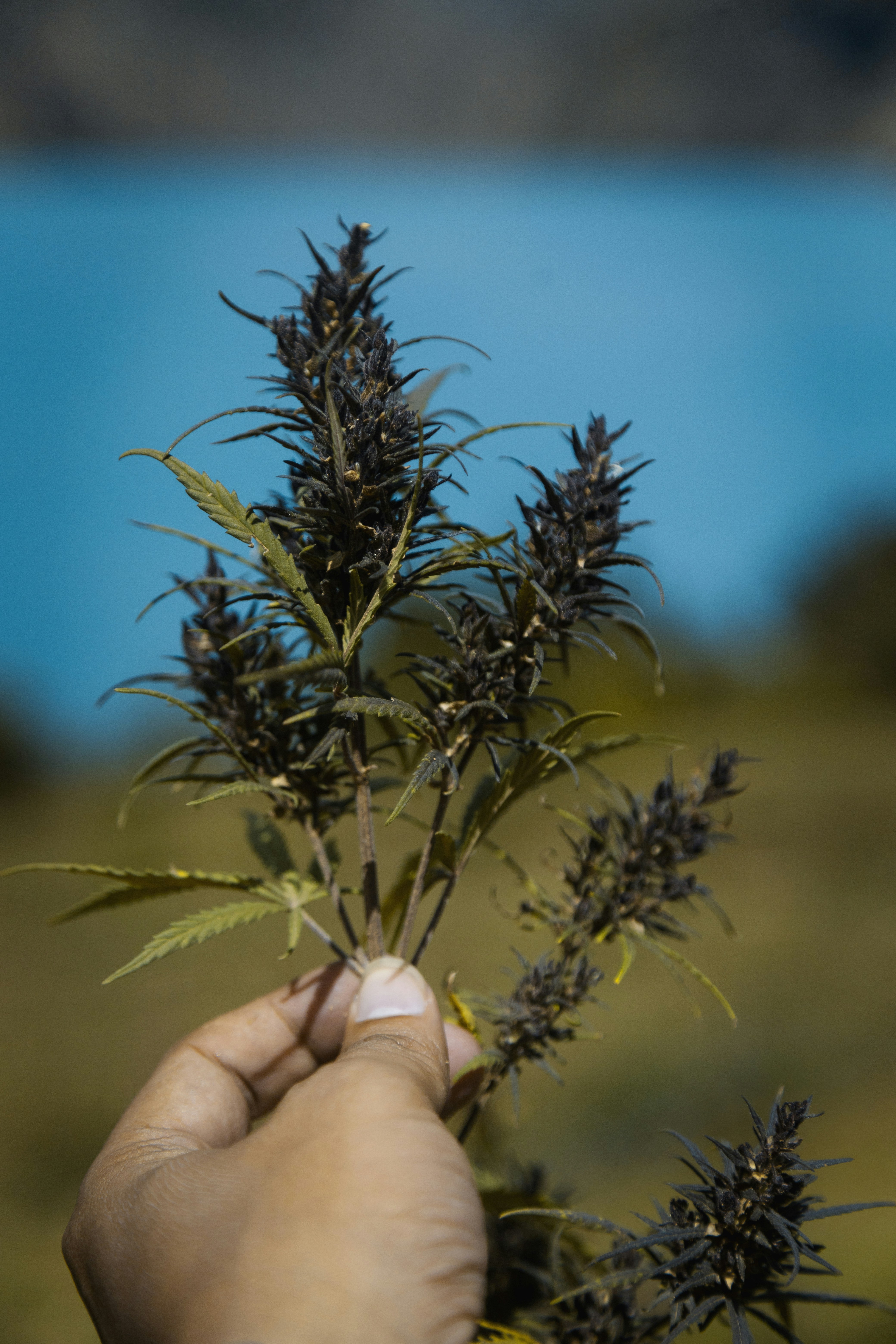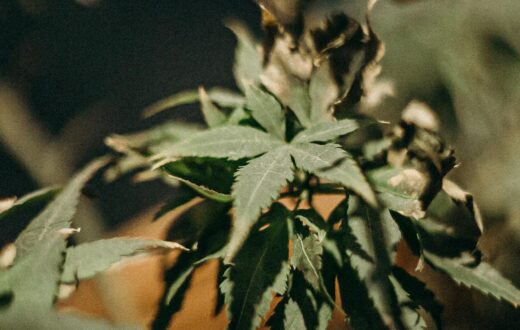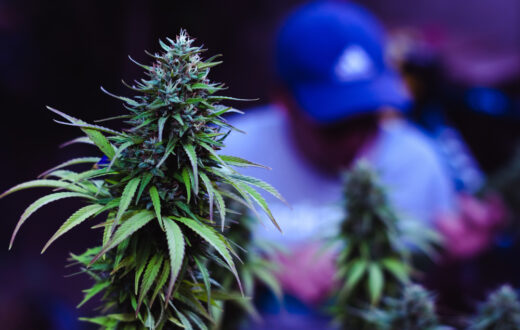Introduction to Blueberry OG Kush
Blueberry OG Kush is a hybrid cannabis strain renowned for its unique lineage, characterized by a blend of Blueberry and OG Kush. This popular strain has garnered attention within the cannabis community for its distinctive flavor profile and exceptional effects. The origins of Blueberry OG Kush can be traced back to the crossbreeding of revered parent strains, creating an offspring that embodies the best qualities of both. Blueberry is known for its sweet, fruity aroma, while OG Kush offers a robust earthy undertone. Together, these genetics result in a flavorful experience that appeals to growers and consumers alike.
The characteristics of Blueberry OG Kush make it especially favored among cannabis cultivators. This strain typically exhibits vibrant, colorful buds that glisten with trichomes, showcasing its potency. The plant itself tends to grow to a medium height, making it suitable for indoor cultivation as well as outdoor environments. It generally grows well in various conditions, provided that proper care is taken in terms of nutrients and light exposure. The flowering period usually lasts between 8 to 10 weeks, allowing for a relatively quick turnaround for growers eager to harvest their crop.
In terms of effects, Blueberry OG Kush is celebrated for providing a balanced experience. Users often report feelings of relaxation and euphoria, making it an ideal choice for evening use or social settings. The unique flavor composition—a blend of sweet blueberry notes and earthy undertones—further cements its status as a favored strain. Beyond personal enjoyment, this strain is also sought after for its potential therapeutic benefits, which may include alleviating stress and offering relief from chronic pain. Overall, understanding how to grow Blueberry OG Kush begins with appreciating its origins, characteristics, and the enjoyable experience it provides to users.
Understanding the Genetics
To successfully cultivate Blueberry OG Kush, it is essential to understand its genetic background. This strain is a hybrid that results from the crossbreeding of two notable parent strains: Blueberry and OG Kush. Each parent contributes unique characteristics that ultimately influence the growth and yield of Blueberry OG Kush. Blueberry, known for its delightful sweet flavor and potent effects, provides a robust genetic foundation. Its lineage hails from the original Blueberry developed by DJ Short in the 1970s, making it a staple in the cannabis community for its stability and high-quality yields.
OG Kush, on the other hand, is revered for its potency and distinctive earthy aroma. This strain has been a significant player in the cannabis scene, tracing its roots back to the California growing scene in the early 1990s. The fusion of these two powerhouses results in a strain that possesses a unique combination of flavor, aroma, and effects, which are sought after by many growers and consumers alike. The genetics of Blueberry OG Kush leads to a balanced experience, often providing both euphoric and relaxing effects that can satisfy diverse user preferences.
Understanding these genetics is critical for cultivating Blueberry OG Kush effectively. The strain typically exhibits a bushy growth pattern, thanks to its indica lineage, which allows for high yields and dense bud formation. Growers can expect shorter flowering times and resilience against common pests and diseases, making this strain relatively easy to manage. Moreover, knowing the genetic influences can help cultivators optimize their growing environment, facilitating the ideal conditions for thriving plants. Familiarity with the lineage and traits of Blueberry OG Kush undoubtedly lays the groundwork for successful cultivation and maximizes the potential of the harvest.
Choosing the Right Cultivation Method
When embarking on the journey of how to grow Blueberry OG Kush, choosing the right cultivation method is a pivotal step that significantly influences the outcome of your harvest. Each method—indoor, outdoor, and greenhouse—offers distinct advantages and challenges that every grower must consider based on their specific circumstances and preferences.
Indoor cultivation is a popular choice among many growers seeking greater control over environmental factors. By growing Blueberry OG Kush indoors, you can maintain consistent temperature, humidity, and light cycles, leading to potentially higher yields and healthier plants. Moreover, indoor growing allows for year-round cultivation, irrespective of external weather conditions. However, it also involves initial setup costs, such as grow lights, ventilation systems, and climate control equipment, which may be a barrier for some.
Conversely, outdoor cultivation harnesses natural sunlight and often results in vigorous plant growth. Growing Blueberry OG Kush outside can yield larger plants with a higher overall biomass. That said, outdoor growers must contend with unpredictable weather patterns, pests, and potential legal issues, especially if cultivation occurs in areas where cannabis regulations are strict. Proper site selection and protective measures are crucial to ensuring successful outdoor growth.
Greenhouse cultivation offers a hybrid solution, combining elements of both indoor and outdoor methods. This approach utilizes sunlight while providing some environmental control, protecting the plants from harsh weather conditions. Greenhouses can help in extending the growing season, making it a suitable option for many growers. However, like indoor growing, greenhouse setups can be costly and require careful monitoring.
Ultimately, the decision of which cultivation method to use for Blueberry OG Kush depends on individual circumstances, including budget, available space, and local climate conditions. By carefully evaluating the pros and cons of each method, growers can select the approach that aligns best with their goals and resources, optimizing their chances for a successful harvest.
Optimal Growing Conditions
To successfully cultivate Blueberry OG Kush, understanding and maintaining optimal growing conditions is vital. This strain thrives under specific environmental factors that significantly impact its growth and overall health. The key conditions include temperature, humidity, light exposure, and soil types.
The ideal temperature range for growing Blueberry OG Kush is between 70°F to 80°F (21°C to 27°C) during the day, with slightly cooler temperatures at night, ideally dropping to about 60°F (15°C). Staying within these parameters promotes healthy growth and enhances the potency and flavor profile of the buds. Extreme temperatures, whether too high or too low, can stress the plants and lead to suboptimal yields.
Humidity levels should also be carefully managed. During the vegetative stage, a humidity level of 40% to 60% is beneficial, while it should be reduced to 40% to 50% during the flowering phase. High humidity can encourage mold and mildew, while low humidity may stunt growth. Regular monitoring with a hygrometer can help growers maintain the right levels.
Light exposure is crucial in developing robust Blueberry OG Kush plants. This strain requires at least 18 hours of light per day during the vegetative stage, transitioning to a 12-hour light-dark cycle during flowering. LED or high-intensity discharge (HID) lights are commonly used for indoor cultivation, as they provide the necessary spectrum for photosynthesis while minimizing heat output.
Lastly, selecting the right type of soil is essential for promoting healthy root development. Blueberry OG Kush grows best in well-aerated, nutrient-rich soil, preferably with a pH between 6.0 and 7.0. Many growers opt for pre-mixed soils designed for cannabis or amend their own soil with organic materials to ensure optimal nutrient availability.
Nutrient Requirements and Feeding Schedule
Understanding the nutrient requirements for Blueberry OG Kush is essential for achieving optimal growth and yield. This strain thrives in a nutrient-rich environment, requiring a balanced supply of macronutrients and micronutrients. The primary macronutrients include nitrogen (N), phosphorus (P), and potassium (K), which are crucial for vegetative growth, root development, and overall plant vigor. During the vegetative phase, a higher nitrogen level is recommended to promote leafy growth. As the plants transition to the flowering stage, the focus should shift towards phosphorus and potassium to enhance bud development and flower quality.
In addition to macronutrients, micronutrients such as magnesium, calcium, iron, and zinc play a pivotal role in the health of the Blueberry OG Kush. These nutrients contribute to various physiological processes, including photosynthesis, chlorophyll production, and nutrient transport. A well-balanced fertilizer specifically designed for cannabis can help meet these needs. Growers should also consider using organic amendments like compost or worm castings, which can enrich the soil microbiome and improve nutrient bioavailability.
When establishing a feeding schedule, it is important to start with lower nutrient concentrations and gradually increase as the plants mature. A typical schedule may involve feeding every two weeks during the vegetative phase and transitioning to a more frequent feeding routine during flowering. Regular monitoring of the plants is crucial, as signs of nutrient deficiencies or excesses can manifest in leaf discoloration, curling, or stunted growth. Yellowing of leaves may indicate nitrogen deficiency, while burnt leaf tips could signify nutrient burn from over-fertilization. A careful approach to nutrient management will ultimately ensure that your Blueberry OG Kush plants flourish, maximizing both yield and potency.
Training Techniques for High Yields
When cultivating Blueberry OG Kush, employing effective training techniques is essential not only for managing plant growth but also for maximizing yield. Three notable methods include topping, low-stress training (LST), and the ScrOG (Screen of Green) technique. Each of these methods can optimize light exposure and promote the healthy development of multiple colas, ultimately leading to better yields.
Topping involves cutting the main stem just above a node, which encourages the plant to grow two new main stems instead of one. This technique should be executed when the plant has developed at least three to four nodes. By topping Blueberry OG Kush, growers stimulate lateral growth and increase the number of growing sites that can be flowered, resulting in an increase in overall yield.
Low-stress training (LST) is another beneficial method that focuses on bending and tying down the branches of the plant to create a more even canopy. This approach not only allows light to penetrate through the entire plant but also encourages the development of side branches. To apply LST, gently bend selected branches down and secure them to the pot or the growing medium using soft ties. This should typically be done during the vegetative stage, allowing the plant to adapt as it grows.
The ScrOG method involves placing a screen above the plant to guide its growth through the grid’s openings. As the Blueberry OG Kush plants grow, the branches are weaved through the screen, ensuring an even distribution of light and preventing overcrowding. This method works best when combined with LST or topping, allowing for optimal utility of space, especially in grow tents or small indoor setups.
In conclusion, utilizing these training techniques effectively can significantly enhance the yield of Blueberry OG Kush. By applying topping, low-stress training, and the ScrOG method at the appropriate stages, growers can ensure robust and fruitful plants, leading to a successful harvest.
Pest and Disease Management
Managing pests and diseases is crucial for successful cultivation of Blueberry OG Kush, as they can significantly impact crop yield and quality. Common pests that may affect this strain include aphids, spider mites, and whiteflies. Each of these pests can cause damage by feeding on plant sap or creating a favorable environment for diseases. Hence, identifying these pests early in the growing process is essential for effective management.
Effective prevention strategies can significantly mitigate pest-related issues. Maintaining optimal growing conditions, such as proper humidity and temperature levels, is fundamental to keeping your Blueberry OG Kush plants healthy and resilient. Additionally, introducing beneficial insects like ladybugs or lacewings can help control pest populations naturally. Regular inspection of plants for early signs of infestations or disease is also recommended, allowing for prompt action if any issues are detected.
Should pest issues arise, both organic and chemical treatment options are available for growers. Organic solutions may include neem oil sprays, which can effectively deter a range of pests without harming the plants. Similarly, insecticidal soaps can be used to eliminate pests while being gentle on the environment. For more severe infestations, chemical pesticides may be necessary; however, it is crucial to select products that specifically target the pests present and to follow application guidelines carefully to minimize plant stress.
In terms of disease management, common fungal infections, such as powdery mildew, can be a concern for Blueberry OG Kush growers. Adopting good air circulation practices, ensuring proper spacing between plants, and avoiding overhead watering can greatly decrease the likelihood of fungal outbreaks. Proper sanitation and disposing of any infected plant material can also prevent the spread of diseases. Overall, an integrated approach that combines good cultural practices with responsive pest and disease management is essential for optimal growth of Blueberry OG Kush.
Harvesting and Curing Blueberry OG Kush
Successfully harvesting Blueberry OG Kush requires keen observation of the plant’s signs of maturity. One of the first indicators that your cannabis plant is ready for harvest is the color of the trichomes, the tiny resin glands on the buds. Using a magnification tool, growers should look for a color change from clear to milky white, with some amber trichomes present. This signifies a peak in cannabinoid development, enhancing both potency and flavor.
In addition to trichome color, the pistils’ appearance plays a vital role in determining the optimal harvest time. When approximately 70-90% of the pistils have transformed from white to a darker color (typically orange or brown), it indicates that the buds are ripe. Timing the harvest precisely can lead to significantly better results, affecting both yield and the overall quality of the Blueberry OG Kush buds.
Once the harvesting phase is complete, the focus shifts to the curing process, which is essential for preserving the distinctive flavors and potency of Blueberry OG Kush. Curing involves drying the buds slowly to reduce moisture content while allowing them to develop their traits further. Ideally, buds should be hung upside down in a dark, well-ventilated area to maintain their aromatic characteristics. Conditions should be monitored carefully, aiming for a temperature of around 60-70°F and a humidity level between 45-55%.
After an initial drying period of about 7 to 14 days, the buds should be transferred to glass jars for the curing phase. It is advisable to open these jars periodically—often referred to as ‘burping’—to release excess moisture and prevent mold growth. Over a few weeks, as oxygen continues to permeate the buds, the rich flavors unique to Blueberry OG Kush will intensify. Mastering the art of curing is ultimately vital for any grower seeking to optimize their final product.
Final Thoughts and Tips for Success
Growing Blueberry OG Kush can be a rewarding venture for both novice and experienced cannabis cultivators. Throughout this guide, we have explored the essential steps for successfully nurturing this unique strain, emphasizing the significance of selecting suitable genetics, providing optimal growing conditions, and implementing effective nutrient management. By adhering to these fundamental principles, growers can unlock the full potential of Blueberry OG Kush, which is renowned for its robust flavor profile and therapeutic benefits.
One of the key aspects to consider is staying updated with the latest advances in cultivation techniques. The cannabis industry is rapidly evolving, with new research and innovative practices emerging regularly. Engaging with reputable sources, such as online forums, webinars, or local grower workshops, can facilitate the learning process. These platforms provide valuable insights, ranging from pest management strategies to nutrient formulations, allowing cultivators to refine their skills and enhance their growing success.
Moreover, fostering a sense of community among fellow cannabis growers can significantly augment the growing experience. Sharing knowledge and experiences with other cultivators can lead to valuable exchanges, helping you discover effective methods for optimizing growth cycles or addressing common issues. The cultivator community often acts as a support network, offering guidance and encouragement through the various challenges inherent in growing Blueberry OG Kush.
Lastly, maintaining a patient and observant approach is vital. Each plant is unique and may require personalized care to thrive. Monitoring your plants closely will help you identify any issues early on, ensuring that you can respond effectively. With dedication and the right techniques, you will be well on your way to mastering how to grow Blueberry OG Kush, ultimately yielding a lush and flavorful crop.












